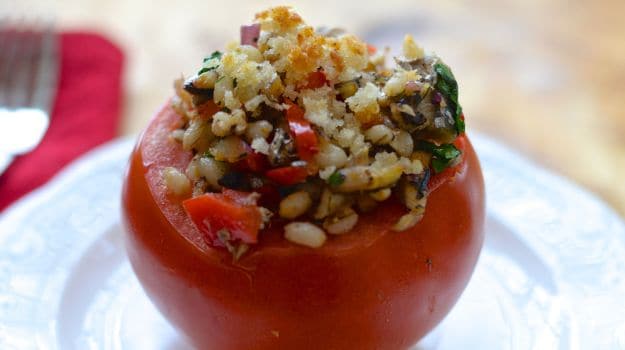Sardinian Tomatoes. Credit: Copyright 2015 Kathy HuntGrowing up with a father who suffered from cardiovascular disease, I learned at an early age how to eat healthfully. Hot dogs, fried chicken and steaks rarely graced our dinner table. Instead, we ate boatloads of low-fat and vitamin- and mineral-rich seafood, grains and produce.Among the fish we consumed, sardines still top my list of favorite heart-healthy foods. Available in fresh and canned forms, these oily fish are chock-full of flavor and omega-3 fatty acids.
What's so great about omega-3s? According to the American Heart Association, these fatty acids lessen the risk of abnormal heartbeats and reduce high triglyceride levels that may contribute to atherosclerosis, or hardening of the arteries. They also have a positive impact on high blood pressure and overall cardiovascular health."It has long been appreciated that societies who eat diets rich in omega-3 fatty acids have a lower incidence of heart disease. For example, prior to the western influences of fast-food chains, Japan, Korea and Southeast Asia had a diet predominantly of fish and had very low heart disease rates. We discovered that one of the main components of the fish diet that was beneficial was omega-3," says Dr. Paul Checchia, director of cardiovascular care at Texas Children's Hospital.Along with sardines' wholesomeness, I love these petite, iridescent fish for their versatility. They go well with an array of other heart-healthy foods, including spinach, tomatoes, red bell peppers, carrots, walnuts, oranges, raisins, kidney beans, black beans and whole grains. They also partner with other omega-3-rich seafood such as anchovies.Sardines lend themselves to many preparations, flavor pairingsWhen fresh, sardines can be grilled, broiled, baked, poached, sautéed or marinated. Their dark, oily flesh responds well to direct heat, making them the perfect fit for barbecues and charcoal grills.Their bold flavor likewise engenders them to simple preparations. Sprinkle ground black pepper, vinegar or citrus juice over your cooked sardines and, in a snap, you've got a delicious repast.Although they tend to be overlooked by today's home cooks, sardines have a long and storied culinary past. Named for the island Sardinia, where they were found in abundance, they have supported generations of European fishermen.Sardines live in both Atlantic and Pacific oceans. In fact, from the 1920s through the 1940s, they served as the backbone of America's largest, most profitable Pacific Coast fisheries. Monterey, California's, famed Cannery Row owes its success to sardines.Canned sardines, in turn, owe their existence to the French and Napoleon Bonaparte, who needed a way to store and transport protein-rich rations for his troops. Through the ingenuity of French brewer Nicolas Appert and British merchant Peter Durand, sardines became the first canned fish and one of the first canned foods.The French weren't the only ones to benefit from sardine canning. In the 20th century these 10- to 14-inch fish fed American soldiers during two world wars. They also provided jobs for vast numbers of workers.As is often the case, rampant popularity led to the sardine's downfall. Overfishing and the ocean's natural growth cycle depleted the supply. Without sardines in the supermarkets, shoppers turned to canned tuna for cheap, portable and easy-to-prepare meals.In recent years sardine populations have rebounded in the Pacific. This is wonderful news for environmentally minded, health-conscious consumers. As small-sized bottom feeders who eat plankton, sardines don't take on heavy metals and PCBs (polychlorinated biphenyls) as other fish do. Low in contaminants and high in protein, vitamins B-12 and D, and omega-3s fatty acids, Pacific sardines have been deemed a "best choice" by Monterey Bay Aquarium's Seafood Watch.When shopping for sardines, I have the option of fresh or canned. With fresh sardines, I look for shiny, silvery skins; plump bodies; bright eyes; and firm, pinkish, moderately oily flesh.Because these fish are fatty, they spoil easily. To ensure my sardines are safe to eat, I do a quick sniff test. If a sardine smells overly fishy or pungent, I skip that fish. Highly perishable, sardines should be cooked the day of purchase.Packed in thick, clear oil, canned sardines possess expiration dates and should be consumed accordingly. Until I'm ready to use them, I store the cans in a cool spot in my kitchen and periodically flip them so all the fish are coated in oil.If you peek into my kitchen cupboard, you'll invariably see at least two tins of sardines tucked in there. I use them in everything from bread spreads and vegetable dips to pastas and pissaladières. When I crave an especially heart-healthy entrée, I make the following dish, Sardinian Tomatoes. Featuring lycopene- and beta-carotene-rich tomatoes; fiber- and iron-packed barley; vitamin C- and A-filled red bell peppers; and, of course, sardines, it's a delightfully nutritious meal.Sardinian TomatoesPrep time: 15 minutes
Cook time: 15 minutes
Total time: 30 minutes
Yield: 8 stuffed tomatoesIngredients-
8 large, ripe tomatoes
1 red bell pepper
1/2 small red onion
8 ounces canned sardines, drained and patted dry
1 1/2 cups cooked barley
1/4 cup fresh flat-leaf parsley
3/4 teaspoon dried thyme
1/2 teaspoon ground black pepper
Juice of 1 lemon
3 tablespoons olive oil, divided, plus more for greasing the baking dish
1/4 cup panko bread crumbs
2 teaspoons granulated onion
1/2 teaspoon saltDirections-1. Preheat the oven to 350 F. Grease a large baking dish with olive oil and set aside.2. Slice off the tops of the tomatoes. Scoop out the seeds, leaving an inch of flesh inside the tomatoes.3. Dice the red pepper and onion. Slice the sardines into bite-sized chunks and put them, along with the pepper and onion, into a mixing bowl. Add the barley to the bowl.4. Roughly chop the parsley. Add it, the thyme and black pepper to the bowl and toss to combine. Drizzle the lemon juice and half of the olive oil over the mixture and toss again.5. In a small bowl combine the bread crumbs, granulated onion and salt. Add the remaining olive oil and stir until all the crumbs are coated.6. Put equal amounts of sardine-barley stuffing into each tomato, filling each to the top. Sprinkle the bread crumb mixture over the filling. Place the stuffed tomatoes in the baking dish and bake, uncovered, for 12 to 15 minutes or until the tomatoes have softened slightly and the crumbs have browned. Remove and serve warm.Copyright 2016 Kathy Hunt via Zester Daily and Reuters Media Express
What's so great about omega-3s? According to the American Heart Association, these fatty acids lessen the risk of abnormal heartbeats and reduce high triglyceride levels that may contribute to atherosclerosis, or hardening of the arteries. They also have a positive impact on high blood pressure and overall cardiovascular health."It has long been appreciated that societies who eat diets rich in omega-3 fatty acids have a lower incidence of heart disease. For example, prior to the western influences of fast-food chains, Japan, Korea and Southeast Asia had a diet predominantly of fish and had very low heart disease rates. We discovered that one of the main components of the fish diet that was beneficial was omega-3," says Dr. Paul Checchia, director of cardiovascular care at Texas Children's Hospital.Along with sardines' wholesomeness, I love these petite, iridescent fish for their versatility. They go well with an array of other heart-healthy foods, including spinach, tomatoes, red bell peppers, carrots, walnuts, oranges, raisins, kidney beans, black beans and whole grains. They also partner with other omega-3-rich seafood such as anchovies.Sardines lend themselves to many preparations, flavor pairingsWhen fresh, sardines can be grilled, broiled, baked, poached, sautéed or marinated. Their dark, oily flesh responds well to direct heat, making them the perfect fit for barbecues and charcoal grills.Their bold flavor likewise engenders them to simple preparations. Sprinkle ground black pepper, vinegar or citrus juice over your cooked sardines and, in a snap, you've got a delicious repast.Although they tend to be overlooked by today's home cooks, sardines have a long and storied culinary past. Named for the island Sardinia, where they were found in abundance, they have supported generations of European fishermen.Sardines live in both Atlantic and Pacific oceans. In fact, from the 1920s through the 1940s, they served as the backbone of America's largest, most profitable Pacific Coast fisheries. Monterey, California's, famed Cannery Row owes its success to sardines.Canned sardines, in turn, owe their existence to the French and Napoleon Bonaparte, who needed a way to store and transport protein-rich rations for his troops. Through the ingenuity of French brewer Nicolas Appert and British merchant Peter Durand, sardines became the first canned fish and one of the first canned foods.The French weren't the only ones to benefit from sardine canning. In the 20th century these 10- to 14-inch fish fed American soldiers during two world wars. They also provided jobs for vast numbers of workers.As is often the case, rampant popularity led to the sardine's downfall. Overfishing and the ocean's natural growth cycle depleted the supply. Without sardines in the supermarkets, shoppers turned to canned tuna for cheap, portable and easy-to-prepare meals.In recent years sardine populations have rebounded in the Pacific. This is wonderful news for environmentally minded, health-conscious consumers. As small-sized bottom feeders who eat plankton, sardines don't take on heavy metals and PCBs (polychlorinated biphenyls) as other fish do. Low in contaminants and high in protein, vitamins B-12 and D, and omega-3s fatty acids, Pacific sardines have been deemed a "best choice" by Monterey Bay Aquarium's Seafood Watch.When shopping for sardines, I have the option of fresh or canned. With fresh sardines, I look for shiny, silvery skins; plump bodies; bright eyes; and firm, pinkish, moderately oily flesh.Because these fish are fatty, they spoil easily. To ensure my sardines are safe to eat, I do a quick sniff test. If a sardine smells overly fishy or pungent, I skip that fish. Highly perishable, sardines should be cooked the day of purchase.Packed in thick, clear oil, canned sardines possess expiration dates and should be consumed accordingly. Until I'm ready to use them, I store the cans in a cool spot in my kitchen and periodically flip them so all the fish are coated in oil.If you peek into my kitchen cupboard, you'll invariably see at least two tins of sardines tucked in there. I use them in everything from bread spreads and vegetable dips to pastas and pissaladières. When I crave an especially heart-healthy entrée, I make the following dish, Sardinian Tomatoes. Featuring lycopene- and beta-carotene-rich tomatoes; fiber- and iron-packed barley; vitamin C- and A-filled red bell peppers; and, of course, sardines, it's a delightfully nutritious meal.Sardinian TomatoesPrep time: 15 minutes
Cook time: 15 minutes
Total time: 30 minutes
Yield: 8 stuffed tomatoesIngredients-
8 large, ripe tomatoes
1 red bell pepper
1/2 small red onion
8 ounces canned sardines, drained and patted dry
1 1/2 cups cooked barley
1/4 cup fresh flat-leaf parsley
3/4 teaspoon dried thyme
1/2 teaspoon ground black pepper
Juice of 1 lemon
3 tablespoons olive oil, divided, plus more for greasing the baking dish
1/4 cup panko bread crumbs
2 teaspoons granulated onion
1/2 teaspoon saltDirections-1. Preheat the oven to 350 F. Grease a large baking dish with olive oil and set aside.2. Slice off the tops of the tomatoes. Scoop out the seeds, leaving an inch of flesh inside the tomatoes.3. Dice the red pepper and onion. Slice the sardines into bite-sized chunks and put them, along with the pepper and onion, into a mixing bowl. Add the barley to the bowl.4. Roughly chop the parsley. Add it, the thyme and black pepper to the bowl and toss to combine. Drizzle the lemon juice and half of the olive oil over the mixture and toss again.5. In a small bowl combine the bread crumbs, granulated onion and salt. Add the remaining olive oil and stir until all the crumbs are coated.6. Put equal amounts of sardine-barley stuffing into each tomato, filling each to the top. Sprinkle the bread crumb mixture over the filling. Place the stuffed tomatoes in the baking dish and bake, uncovered, for 12 to 15 minutes or until the tomatoes have softened slightly and the crumbs have browned. Remove and serve warm.Copyright 2016 Kathy Hunt via Zester Daily and Reuters Media Express
Advertisement






